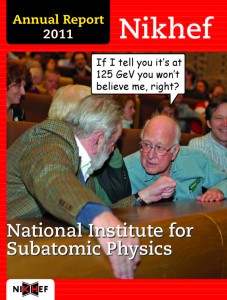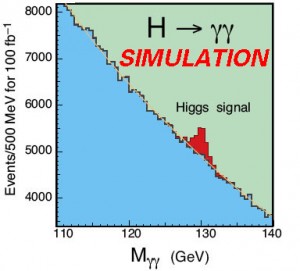
89-94 kg is what I, much to my chagrin, read every Sunday morning when I step on my scale. And if you think about it: all this is the fault of the Higgs particle (denoted H), the generator of mass[1]. At least if the symmetry breaking mechanism (the Higgs mechanism, as implemented and first hypothesized by Higgs, Brout and Englert in 1964) in the Standard Model of elementary particle physics is correct. The Higgs mechanism is an ingenuous (and, very important, mathematically consistent) way to ‘explain’ a fundamental difference (i.e. symmetry breaking) between two of the forces in nature incorporated in the Standard Model: the long range of the electromagnetic force versus the short range of the weak nuclear force. In particle physics terminology[2] this boils down to:
Why is the mediator of the electromagnetic force (the photon, γ) massless i.e.
my=0 GeV/c2 while the mediators of the weak nuclear force (the W- and Z-bosons) are massive i.e. mW≈80 GeV/c2 and mZ≈91 GeV/c2?
The Higgs mechanism requires the entire Universe to be filled by a field (the Higgs field) in a peculiar ground state thereby rendering mass to the W- and Z-bosons while keeping the photon strictly massless. I admit this sounds very tricky and technical, but in essence similar symmetry breaking events happen in phenomena like ferromagnetism, superconductivity and the ordinary buckling of a compressed needle i.e. the transition from an a-priori (rotational) symmetric environment to a state with a preferred direction in space with lower energy. A bonus of the Higgs mechanism is that it can also be used to render mass to the elementary matter particles i.e. the so-called leptons: electron (e), muon (μ) and tau (τ) and their corresponding neutrinos (electron-neutrino, muon-neutrino and tau-neutrino) as well as the so-called quarks up (u), charm (c), top (t) and down (d), strange (s) and bottom (b). In the absence of the Higgs mechanism all these matter particles would also be massless; in flagrant contradiction with my weekly Sunday morning experience! Last but not least: the Higgs mechanism predicts the existence of a new and unique particle: the Higgs particle! To be clear, the Higgs is not yet another matter particle like the electron, neutrino or quark. Neither is the Higgs a force mediating particles like the photon, gluon or W- and Z-boson. But, once discovered, the Higgs will be the first particle in an entirely new league! Within the Standard Model all properties of the Higgs particle are known with the exception of its mass. To date the Higgs particle is the only ingredient of the Standard Model lacking experimental observation. As such it is not surprising that the quest for the Higgs particle discovery is the main trust of experimental elementary particle physics as best exemplified by the gigantic scale of CERN’s Large Hadron Collider (LHC) project with its primary aim of concluding the Higgs hypothesis. Preferentially by the unambiguous discovery of the Higgs particle or, if all else fails, by the exclusion of the existence of the Standard Model Higgs particle.
So leaving the theory aside: What is the experimental status of the Higgs?
LEP
The Higgs created a lot of excitement in the final days of CERN’s previous flagship accelerator: the Large Electron Positron collider or in short LEP. A few LEP events matched the hunted after e+e–→ZH topology[3] hinting at a Higgs mass of around 114.5 GeV/c2; just about the kinematic limit set by the highest LEP center-of-mass energies achieved. However, the signal was too marginal to claim a discovery. Imagine if people had listened more intently to Dutch Nobel laureate Martinus Veltman who already in the 1970s advocated that LEP should reach 300 GeV center-of-mass energies! Instead all LEP could finally conclude about the mass of the Higgs was that it must exceed 114 GeV/c2 and that, within the context of the Standard Model, a light Higgs (i.e. a Higgs mass well below about 185 GeV/c2) is favoured. These LEP constraints are shown as the green exclusion bands in the figure below.

After the closure of LEP in the year 2000, Fermilab’s Tevatron (USA) took over the Higgs hunt. The Tevatron is a 2 TeV center-of-mass proton–antiproton collider. At such a machine the dominant Higgs production process is through quark–antiquark annihilation into a W- or Z-boson with subsequent radiation of a Higgs i.e. a final state including a WH or ZH pair. The analysis of these final states in the presence of the debris of the proton and antiproton is infinitely more difficult than the super clean Higgs production signature at LEP. So difficult in fact that the final result is not yet public even though the Tevatron already shut down in 2011. What is clear is that the Tevatron results corroborate the LEP findings in favour of a light Standard Model Higgs and that a bit more of the Higgs mass range allowed by LEP can be excluded as sketched in orange in the above figure (the final Tevatron result will exclude a bit more and possibly even show a hint of Higgs production).
LHC
The LHC is designed to conclude the Standard Model Higgs saga. This means that irrespective of its mass the LHC will be able to either discover or refute the Standard Model Higgs. As opposed to Higgs production at the Tevatron, the dominant LHC Higgs production mechanism is through gluon–gluon fusion (the gluon is the mediator of the strong nuclear force) i.e. two gluons produce (via an intermediate top quark-pair) a Higgs particle. The Higgs particle immediately decays and, depending on the Higgs mass, very clean signatures can be isolated. In the Higgs mass range of interest, i.e. the light Higgs mass scenario 115-150 GeV/c2, two Higgs decay channels are favored:
H→ZZ→eeee, eeµµ or µµµµ; and
H→γγ.

In here “µ” represents the muon, a heavy replica of the electron. Particles like electrons, muons and photons can be recognized and measured by the LHC detectors with excellent precision and hence allow precise reconstruction of the Higgs mass. In the adjacent figure this is shown for simulated data for a hypothetical Higgs mass of 130 GeV/c2 and on a ten times larger data sample than available to date (June 2012). The Higgs mass peak (in red) clearly stands out above the continuous γγ background.
Now for real LHC data: The first excitement came in on 13 December 2011 when during a joint ATLAS and CMS colloquium at CERN the two main LHC experiments reported their Higgs results to a packed auditorium at CERN and simultaneously to people all over the world. The message was clear: with the exception of a tiny window in the vicinity of 125 GeV/c2 the Standard Model Higgs was excluded! To raise the excitement, several Higgs candidate events were found near 125 GeV/c2 by the two experiments but their significance fell short to claim a discovery (the so-called 5-sigma criterion which basically rules out a background fluctuation mimicking the signal by 1 in 10 million). Next week CERN again organizes a joint ATLAS and CMS colloquium. Each collaboration doubled its 2011 data sample. Stay tuned and meanwhile you can admire Nikhef’s annual report 2011 cover shown on top and wonder whether or not (future Nobel laureate?) Peter Higgs is right about the outcome of the quest for the Higgs particle!
Footnotes:
[1] Strictly speaking this is only true for the electrons i.e. a meager per mille of our body mass. The bulk of our body mass is due to the atomic nuclei i.e. the protons and neutrons which in turn are composed of quarks: up-up-down (‘uud’) for the proton and up-down-down (‘udd’) for the neutron. Even though the Higgs gives mass to the u- and d-quarks, the actual mass of protons and neutrons stems from the binding energy of the quarks composing protons and neutrons via E=mc2!
[2] In elementary particle physics masses are quoted in units of GeV/c2=109 eV/c2 with 1 eV/c2 being the energy an electron gains if accelerated by a 1 V battery and c the velocity of light in vacuum.
[3] In here e+ and e– represent the positron and the electron, respectively. The reaction e+e–→ZH means in words: the positron and electron annihilate one another creating a Z-boson which radiates a Higgs particle i.e. creating the “ZH” final state.
On the 4th of July, CERN is to give an update on the Higgs search as a curtain raiser to the ICHEP conference. For more information about the seminar and press conference, go to:
http://press.web.cern.ch/press/PressReleases/Releases2012/PR16.12E.html